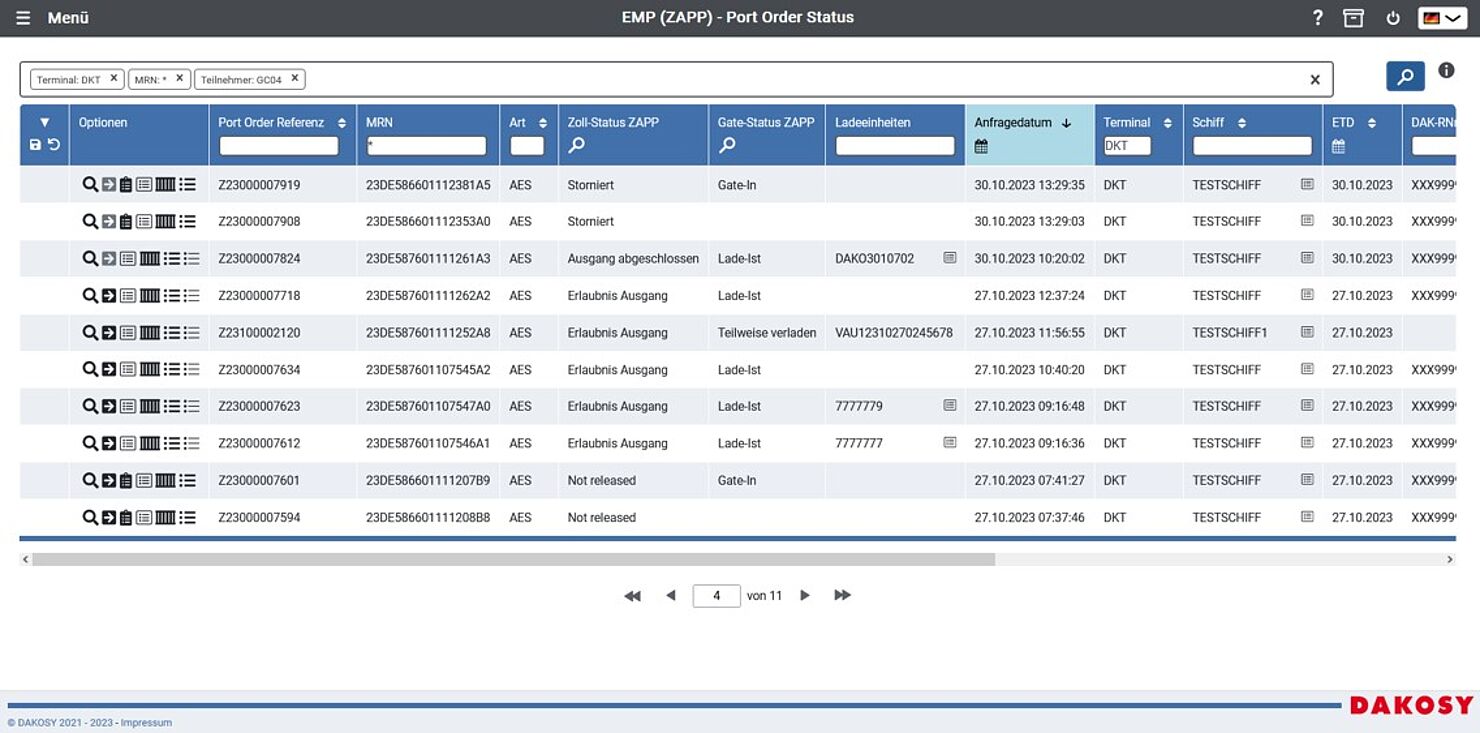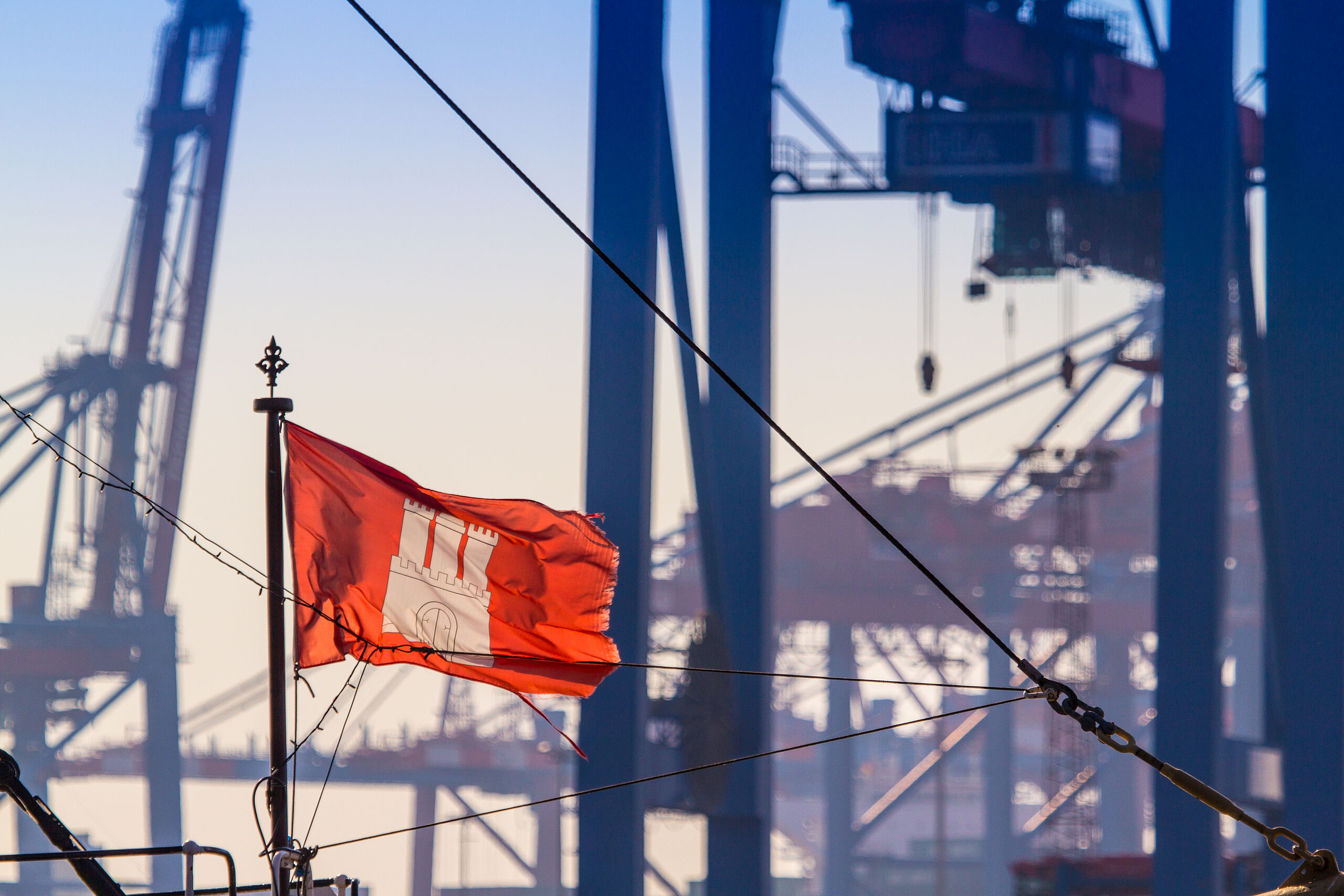Article • 18.12.2023
ZAPP is now EMP
Re-designed export process
Anyone who regularly exports goods through the Port of Hamburg knows ZAPP. The IT platform is a guarantor for export-related port communication among the stake-holding participants. Now, the functionalities and applications that have grown and evolved over the course of many years will be newly released under the name EMP. Highlights include the new web application that integrates all current ZAPP functions, a login for all status inquiries, convenient and modern user interfaces, and the establishment of the XML standard for all interfaces.

The IT platform ZAPP stands for customs export monitoring in the Paperless Port and was introduced by DAKOSY, working together with the port industry, as a comprehensive and mandatory IT system for exports processed through the Port of Hamburg starting in July 1997. Under the umbrella of the ZAPP platform, a wide range of services were as added in the following years — some new, but also some features from DAKOSY's earlier days.
ZAPP’s many facets and broad palette of functionalities have been undergoing a technical renewal since 2020. "Outwardly, this development is most visible in the new nomenclature. Under the EMP brand, we're bringing together the entire ZAPP family, including all services such as ZAPP@Gate and ZAPP@Status," explains Kai Stanislaus, who is responsible for the project at DAKOSY. The Hamburg-based software provider has allocated four years for the implementation of the project, which is scheduled to be completed by the end of 2024.
Many results are already tangible. The pilot phase is underway. Stanislaus specifies: "This includes the web application. Authorized users are provided with a showcase window for the export data exchanged via the platform. It offers a modern user interface, diverse filtering options, a unified login, and more." However, the lion's share of the project is invisible to users. Stanislaus estimates that about seven-eighths of the technical innovations operate in the background. There, the focus lies on establishing XML interfaces for data transmission, an internationally recognized common standard.
EMP tested in real-life situations
Our pilot partners Zollagentur Behlich, the EUROGATE container terminal and the Hamburg customs office report on their initial experiences with the new EMP
Pilot partner for the interface
Sara-Louise Behlich, owner and managing director of the Hamburg-based customs agency that bears her name, is a pilot partner using the Port Order XML interface. In her business activities, she covers a wide range of exports — both in terms of the variety of goods and different types of customs declarations. As part of the pilot, she input the different messages using the forwarding software CargoSoft GE and transmitted them to the new EMP via the XML interface. Behlich shares her impressions: "During the test phase, we were able to map 80 percent of all declaration document variants -- from containers to Ro/Ro and Breakbulk, all types of goods were represented."
All messages she registered were using real data, allowing EMP to be tested under live conditions. It was particularly helpful that all "messages" went straight across Behlich's desk. She knew every declaration case personally and could provide direct feedback if there was additional room for optimization. A special focus was on ensuring bi-directional communication — in other words, data exchange in both directions. Behlich gives an example: "If I transmit a port data record, I need to receive the Z-, B- or S-number in return and then later, the customs release or another customs directive needs to come through." The customs expert asserts that the new EMP platform, just like its predecessor ZAPP, is a most reliable and also a modern system. Behlich's assessment of the pilot phase is positive: "Thanks to the consistently professional support and particularly the real-time monitoring, obstacles were quickly overcome and all shipments using an EMP declaration were loaded on time. The system's programming is highly complex; as an IT specialist, I can really appreciate the performance of the entire project team. I'm looking forward to the final implementation."
EMP web application in test operation
For Marcus von Pruski and his team at EUROGATE, the services provided by ZAPP@Gate and ZAPP@Status have been crucial for their daily operations. As pilot partners, they have now tested the new EMP web application for their processes. Von Pruski details using the platform: "In EMP, the functions ZAPP@Gate and ZAPP@Status have been merged. With a single log-in, we can now, for example, check unclear containers, which is part of our daily activity. The workflow is much smoother, since we no longer need to switch between the ZAPP worlds."
Approximately two or three days before the vessel arrives, von Pruski and his team start checking which of the soon-to-be-loaded containers still has an uncertain status. This includes containers that have not yet been delivered or are not yet released by customs. Until about six hours prior to the ship's docking, they can investigate the cause; after that, the container remains stationary. "EMP is an important working tool and provides us with vital information via the stored status as to why some export containers are unclear." In addition to the easier handling, von Pruski is also enthusiastic about the modern and visually clear interface. "All in all, it’s very appealing and functional," is his conclusion.
Involved from the beginning
As the main focal point for exports from the Port of Hamburg, customs was involved in the changeover from the outset. In May 2022, DAKOSY provided the EMP web application as the successor to the ZAPP application to the Hamburg Customs Office, Area 30. For Ricarda Zahn and Mathias Faber from the Hamburg Customs Office, the new application meets all necessary criteria: "EMP primarily serves as the interface to customs' ATLAS procedures and supports economic operators in transmitting participant messages from the (arrival) presentation of goods in the Port of Hamburg through to the release for exit and further processes until the exit confirmation."
Most importantly, all functionalities of ZAPP have been adopted so there are no fundamental changes in their daily work. The continuity is essential because customs officials should also be able to easily navigate the new platform. However, there is still room for new features. Zahn and Faber report on their experiences: "User comfort has now been adapted to current standards. This manifests itself in the intuitive and clear operation. Moreover, with the new web-based application, remote access and processing when working from home are now possible."

"Outwardly, this development is most visible in the new nomenclature. Under the EMP brand, we're bringing together the entire ZAPP family, including all services such as ZAPP@Gate and ZAPP@Status."


